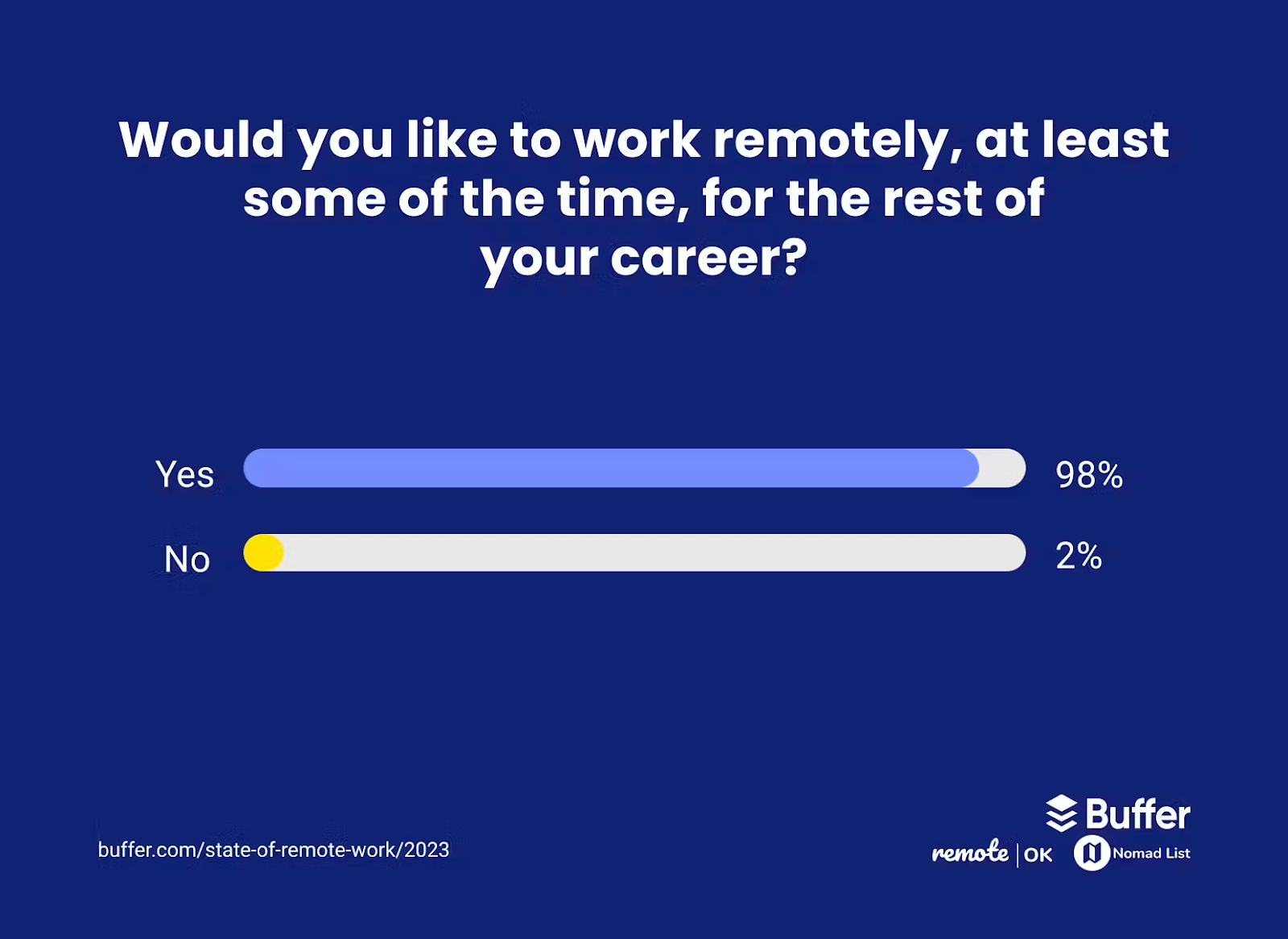How to Convince Your Company to Embrace Remote Work
Convincing your company to embrace flexible remote work for your UX team

As the global workforce becomes increasingly digital, many UX teams are embracing remote work as a viable option. While remote work has numerous benefits, such as increased productivity, reduced overhead costs, and access to a larger talent pool, it can be challenging to convince stakeholders in your company to adapt to this new flexible way of working.
However, it's crucial to clarify that we are not advocating for teams to be fully remote, unless that suits your teams needs. Instead, we suggest that companies should avoid adopting rigid return-to-office policies that force people back into the office. These policies can potentially sacrifice employee well-being for immeasurable or even marginal gains in productivity. Let’s explore some key strategies for convincing your company to adopt a more flexible approach towards remote work for your UX team.
Highlight the benefits of remote work
The first step in convincing your company to keep your UX team remote is to highlight the benefits of remote work.
Are you more productive having people physically in an office together and then constraining who you hire to a 30-mile or a 60-mile commuting radius to the office? Or by allowing your team to be able to hire people from anywhere?
Brian Chesky, CEO of Airbnb
Here are of the benefits of remote work:
- Reduced Attrition: Remote work can lead to happier employees, reducing the chances of them leaving their jobs. This, in turn, reduces the cost of recruiting and training new employees.
- Reduced commuting costs: Remote workers can save money on transportation costs, such as gas, parking, and public transportation.
- Boosting productivity: Although measuring productivity can be challenging, research shows that a flexible working environment promotes happier and less-stressed employees who have a better work-life balance. As a result, employees can focus and avoid interruptions from office distractions, and schedule their work hours more efficiently.
- Improved work-life balance: Remote workers often have a better work-life balance because they can work from home and avoid the long commute. This can lead to less stress and burnout.
- Increased employee satisfaction: Remote workers are often more satisfied with their jobs than their in-office counterparts. This is because they have more flexibility and control over their work.
- Reduced office space costs: Companies that offer remote work options can save money on office space costs. This is because they do not need to provide office space for all of their employees.
- Increased access to talent: Companies that offer remote work options can hire from a wider pool of talent. This is because they are not limited to hiring people who live in the same area as their office.
- Reduced environmental impact: Remote work can help to reduce the environmental impact of commuting. This is because fewer people are driving to and from work.
- Fluid collaboration and documentation: When a team works digitally its a lot easier to keep track of the digital footprints they leave. Be it in Figma, Miro, Slack, Email; most of the in-office collaboration problems have already been solved by the digital tools we use today.
By emphasizing these benefits, you can make a strong case for why remote work is a smart choice for your company.
Back it up with data
When you approach your company with the proposal to keep your UX team remote, it's important to back up your claims with data. Collecting data internally by conducting surveys or showcasing other companies who are doing so can be a great way to demonstrate the success of remote work within your team.
Here are some examples of things that an internal survey of the UX team might measure to help back up your case for remote work:
- Productivity: Gather data on the team's productivity levels before and after the switch to remote work. This can include metrics such as the number of designs created, the number of revisions needed, and the time it takes to complete a project. If you lack concrete numbers you can conduct a survey with your cross-functional partners and your team to help support your case. Also quotes from other department leaders will help.
- Work-life balance: Collect data on the team's satisfaction with their work-life balance since the switch to remote work. Ask questions about how often they feel they have to work outside of regular business hours and how often they take breaks during the workday.
- Collaboration and communication: Ask team members how well they feel they are able to collaborate and communicate with each other while working remotely. This can include questions about the effectiveness of virtual meetings, how often they communicate with each other outside of meetings, and how well they feel they are able to share ideas and feedback.
- Employee retention: Measure how many team members have voluntarily left the company since the switch to remote work and compare that to previous years. This can help show whether remote work is having a positive or negative impact on employee retention.
- Cost savings: Measure how much the company has saved on things like office space, utilities, and equipment since the switch to remote work. This can help demonstrate the financial benefits of remote work to the company.
By collecting data on these and other relevant metrics, you can build a strong, measurable case for why remote work is a good option for the UX team and the company as a whole.
Address concerns about remote work
While there are many benefits to remote work, some companies may be hesitant to make the switch due to concerns about communication and collaboration. To address these concerns, it's important to highlight the numerous digital tools and technology available for remote collaboration, such as video conferencing, instant messaging, digital whiteboard tools and project management software.
Additionally, you can offer to establish clear communication protocols and provide regular check-ins to ensure that everyone is on the same page.
Here is a list of potential concerns so you will know what you might be up against:
- Productivity: Remote workers may not be as productive as in-office workers.
- Collaboration: It can be difficult to collaborate and build relationships with colleagues when you're not in the same place.
- Isolation: Remote workers may be more likely to experience isolation and loneliness.
- Management: It can be difficult to manage remote workers.
- Payroll Concerns: For companies wanting to hire a global remote workforce, there are now great companies like Plane (we use them), Deel and Papaya that make this easier. Also for those concerned about paying people domestically companies like Justworks (we use them) make it easy to use them as a PEO and setup payroll in each state.
Make a plan for successful remote work
Before making the switch to remote work, it's important to make a plan for success. This plan should include the following:
- Set clear expectations: Before you make the switch to remote work, it's important to set clear expectations with your team. This includes expectations about work hours, communication, and collaboration.
- Establish communication protocols: It's important to establish clear communication protocols for your team. This includes how often you will communicate, what tools you will use, and how you will handle urgent issues.
- Measure success: It's important to measure the success of your remote work program. This will help you to identify what is working well and what areas need improvement.
- Provide training and resources: You can provide training and resources to your team to help them to be successful in remote work. This can include training on how to use the tools you will be using, how to manage their time effectively, and how to stay connected with their colleagues.
- Address existing gaps: If there are any existing gaps in your company's remote work program or in-office program that may be of concern to the organization, you can address them in your plan. This could include things like providing more training, providing more resources, or creating a more flexible work environment to compensate.
Showcase successful remote work examples
One of the best ways to convince your company to keep your UX team remote is to showcase successful remote work examples. This could include case studies, testimonials from other remote UX teams, and success stories from your own team. By highlighting the positive outcomes of remote work, you can show your company that it's a viable and effective option.
WordPress
Noted for its leadership in open-source content management systems, WordPress has been at the forefront of remote work for several years. Its commitment to a decentralized structure since its founding in 2003 enables employees to work globally.
The founder of Automattic, the firm behind the publishing platform, Matt Mullenweg, is a staunch supporter of this decision and has even initiated a podcast discussing it.
Increasing the number of distributed companies is one of my life missions. It is beneficial for the environment, for opportunities, and for the company...
Mullenweg shares with the New York Times.
For the executives, it extended beyond a mere business choice. It was a decision to alter a fundamental component of their culture. They discovered that remote work provides more flexibility and autonomy for their employees, leading to enhanced productivity and job satisfaction. Currently, they can attract the best global talent, irrespective of their location.
Their successful approach stems from promoting asynchronous work, allowing employees to work at their preferred timing. This indicates a strong sense of trust from the top management to the employees, who respond positively. In fact, he's indicated that his distributed team often requires more vacation or break time. Therefore, they've put measures in place to encourage those constantly attached to their screens to take some time off.
GitLab
GitLab is another commendable instance of a positive remote work culture. This code-management platform has always been fully remote-first, vocal about this philosophy, and shares detailed insights about their approach on their website.
In their manifesto, they propose that all-remote work encourages:
- Global hiring and working
- Flexible work hours
- Documentation and recording of knowledge
- Documented processes
- Public information sharing
- Allowing anyone to edit documents
- Asynchronous communication
- Outcome-oriented work
- Formal communication channels
Transparency and open communication are vital elements of GitLab's remote work culture. Their entire handbook, which provides their policies and procedures, is available to anyone online. This level of openness promotes trust and accountability among remote team members.
All-remote work is the new normal delivering countless benefits to companies and team members alike...
Sid Sijbrandij, the co-founder and CEO of GitLab
GitLab also emphasizes employee autonomy and self-management. Employees have the freedom to work as and when they prefer, provided they meet the company's expectations for productivity and results. This strategy nurtures a sense of ownership and responsibility among employees.
Airbnb
Recently, Airbnb joined the roster of tech giants embracing complete remote work. Last April, CEO Brian Chesky declared that employees could work and reside anywhere globally.
Today, we’re announcing that Airbnb employees can live and work anywhere.
— Brian Chesky (@bchesky) April 29, 2022
Our design for working at Airbnb has 5 key features:
He also shared five key components of their approach:
- Employees can opt between home or office.
- Compensation will not depend on location.
- They can live and work in up to 170 countries, with a limit of 90 days per year in each location.
- Airbnb will organize quarterly in-person team meetings.
- The company will adhere to a multi-year roadmap with biannual major product launches to maintain high-level coordination.
Following this announcement, the Airbnb careers page saw millions of people clicking on their jobs page.
Some more useful linkes:
- GitLab's Guide to All-Remote
- Buffer’s Everything We Know About Remote Work
- Zapier’s Ultimate Guide to Remote Work
These are just a few examples of companies that have embraced a more flexible remote work culture and have been successful at it. As the world continues to shift to a more remote workforce, it will be interesting to see how these companies continue to innovate and adapt.
Arming yourself with numbers
Remote UX teams can offer a number of benefits to companies, including financial savings, increased productivity, improved employee morale, and reduced turnover. Investing in employee well-being by supporting remote work can lead to increased employee satisfaction, which in turn leads to improved productivity and retention. This ultimately results in increased revenue, decreased costs, and a competitive advantage.
According to a Harvard Business Review article about remote work, leaders at GitLab, too, pointed to employee retention as a positive outcome of the company’s decision to be all-remote. The net benefit, they believe, including the productivity increases and property cost savings they’ve seen, equals $18,000 a year for each worker..
Dispel the notion that Remote or In-Office workers are also more likely to be productive than one another. As discussed in the article “Your boss is obsessed with productivity without knowing what it means”. The emphasis on productivity in remote work can seem disingenuous. Companies raked in record profits during the pandemic, even though their employees were working from home. Many companies use metrics like hours worked or number of tasks completed to measure productivity, but these metrics can be misleading. Productivity is not the only measure of success, and companies should focus on creating a positive work environment for employees.
In addition, remote workers are more likely to be happy with their jobs and less likely to leave for a better opportunity. A study by Buffer found that 98% of remote workers want to work remotely for the rest of their careers and 98% would also recommend remote work to others.

By arming yourself with data on the financial benefits and tax incentives associated with remote work, you can make a compelling argument for why it make sense financially for your company to keep your UX team remote.
Be flexible
Finally, it's important to be flexible when making the case for remote work. Your company may have concerns or reservations that you haven't considered, so it's important to be open to feedback and willing to make adjustments to your plan. By being flexible and working collaboratively, you can create a plan for successful remote work that meets the needs of your company.
I do not think the future is remote. I think the future is flexible...We want to combine the best of Zoom with the best of being together...We don’t want to recreate this world of Wall-E where everyone’s just staring at screens all day and no one has any interaction in the physical world.
Brian Chesky, CEO Airbnb
Convincing your company to keep your UX team remote can be a challenging and time-consuming task, but it's not impossible. By highlighting the benefits of remote work, addressing concerns, making a plan for success, showcasing successful remote work examples, and being flexible, you can make a strong case for why remote work is a smart choice for your company. Ultimately, by embracing remote work, you can improve productivity, access a larger talent pool, and create a more inclusive and flexible work environment for your UX team.
At Academy, our internal operations prioritize a remote-first approach; however, we offer versatile options, including freelance and full-time resources, catering to your team's needs whether it's remote or on-site. Our advocacy for flexible policies isn't rigid; instead, it's a belief we aim to share with our clients. Our goal is to enlighten clients about the numerous benefits of such policies. These advantages not only enable your team to fully leverage the potential of remote work but also grant access to a wider spectrum of talent. Contact us to learn more about working with us to find your next flexible resource.






